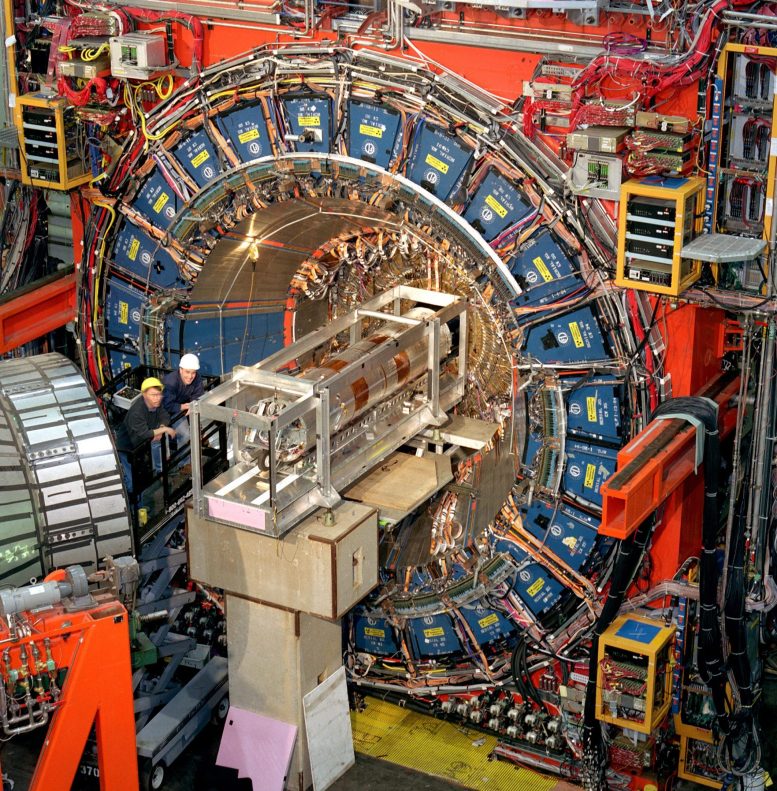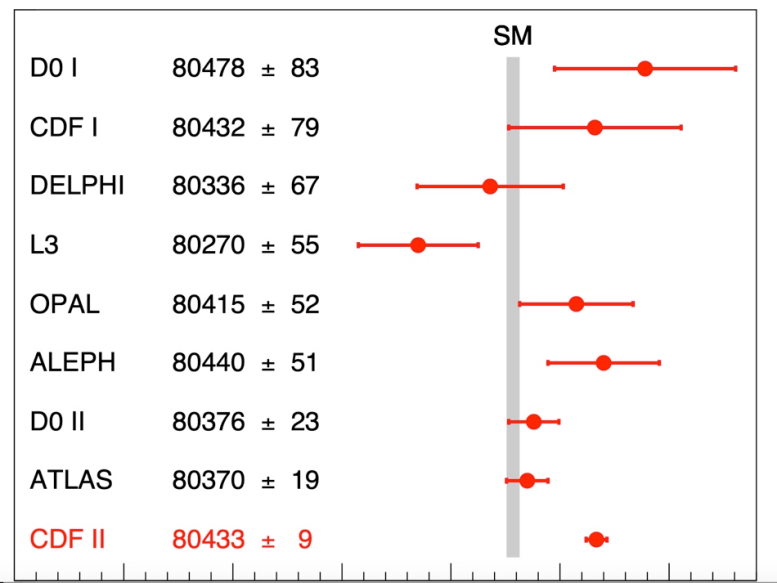Najdokładniejszy kiedykolwiek pomiar masy bozonu W pokazuje napięcie za pomocą Modelu Standardowego.
Po 10 latach dokładnych analiz i badań naukowcy CDF z Narodowego Laboratorium Fermiego Fermi National Accelerator Laboratory w amerykańskim Departamencie Energii ogłosili 7 kwietnia 2022 r., że osiągnęli najdokładniejszy dotychczas pomiar masy bozonu W, jednej z sił natury. przenoszenia cząstek. Korzystając z danych zebranych przez Detektor Zderzaczy Fermilab lub CDF, naukowcy określili teraz masę cząstki z dokładnością 0,01%, czyli dwukrotnie większą od poprzedniego najlepszego pomiaru. Odpowiada gorylowi ważącemu od 800 funtów do 1,5 uncji.
Nowa waga precyzyjna opublikowana w czasopiśmie Nauki ścisłe, pozwala naukowcom przetestować Model Standardowy fizyki cząstek elementarnych, ramy teoretyczne opisujące naturę na jej najbardziej podstawowym poziomie. Wynik: nowa wartość masy pokazuje napięcie z wartością, którą naukowcy uzyskują przy użyciu eksperymentalnych i teoretycznych danych wejściowych w kontekście Modelu Standardowego.

Detektor zderzaczy Fermilab zarejestrował zderzenia cząstek wysokoenergetycznych generowane przez Zderzacz Tevatron w latach 1985-2011. Około 400 naukowców z 54 instytucji w 23 krajach wciąż pracuje nad bogactwem danych zebranych w eksperymencie. Źródło: Fermilab
„Liczba ulepszeń i dodatkowych walidacji, które zostały wprowadzone do naszych wyników, jest ogromna” – powiedział Ashutosh V. Kotwal z Duke University, który prowadził tę analizę i jest jednym z 400 naukowców współpracujących z CDF. „Wzięliśmy pod uwagę nasze lepsze zrozumienie naszego detektora cząstek, a także postęp w teoretycznym i doświadczalnym zrozumieniu interakcji bozonu W z innymi cząstkami. Kiedy w końcu ujawniliśmy wynik, stwierdziliśmy, że różni się on od przewidywań Modelu Standardowego. „
Jeśli zostanie potwierdzony, pomiar ten wskazuje na potencjalną potrzebę ulepszeń kosztem Modelu Standardowego lub rozszerzeń Modelu.
Naukowcy określili teraz masę bozonu W z dokładnością do 0,01%. Jest to dwukrotna dokładność poprzedniego najlepszego pomiaru i pokazuje napięcie w przypadku modelu standardowego.
Nowa wartość jest zgodna z wieloma poprzednimi pomiarami mas bozonów W, ale są też pewne różnice. Potrzebne będą przyszłe pomiary, aby rzucić więcej światła na wynik.
„Chociaż jest to interesujący wynik, pomiar musi zostać potwierdzony przez inny eksperyment, zanim zostanie on w pełni wyjaśniony” – powiedział zastępca dyrektora Fermilab, Joe Lykken.
Bozon W jest cząstką przekaźnikową słabego oddziaływania jądrowego. Odpowiada za procesy jądrowe, dzięki którym słońce świeci, a cząsteczki ulegają rozkładowi. Wykorzystując zderzenia wysokoenergetycznych cząstek ze zderzacza Tevatron w Fermilab, współpraca CDF zebrała ogromne ilości danych zawierających bozony W w latach 1985-2011.

Bozon W jest cząstką przekaźnikową słabego oddziaływania jądrowego. Odpowiada za procesy jądrowe, dzięki którym słońce świeci, a cząsteczki ulegają rozkładowi. Naukowcy z CDF badają właściwości bozonu W, korzystając z danych zebranych w Zderzaczu Tevatron w Fermilab. Źródło: Narodowe Laboratorium Akceleratora Fermi
fizyk CDF Chris Hayes z[{” attribute=””>University of Oxford said, “The CDF measurement was performed over the course of many years, with the measured value hidden from the analyzers until the procedures were fully scrutinized. When we uncovered the value, it was a surprise.”
The mass of a W boson is about 80 times the mass of a proton, or approximately 80,000 MeV/c2. CDF researchers have worked on achieving increasingly more precise measurements of the W boson mass for more than 20 years. The central value and uncertainty of their latest mass measurement is 80,433 +/- 9 MeV/c2. This result uses the entire dataset collected from the Tevatron collider at Fermilab. It is based on the observation of 4.2 million W boson candidates, about four times the number used in the analysis the collaboration published in 2012.

The mass of a W boson is about 80 times the mass of a proton, or approximately 80,000 MeV/c2. Scientists of the Collider Detector at Fermilab collaboration have achieved the world’s most precise measurement. The CDF value has a precision of 0.01 percent and is in agreement with many W boson mass measurements. It shows tension with the value expected based on the Standard Model of particle physics. The horizontal bars indicate the uncertainty of the measurements achieved by various experiments. The LHCb result was published after this paper was submitted and is 80354+- 32 MeV/c2. Credit: CDF collaboration
“Many collider experiments have produced measurements of the W boson mass over the last 40 years,” said CDF co-spokesperson Giorgio Chiarelli, Italian National Institute for Nuclear Physics (INFN-Pisa). “These are challenging, complicated measurements, and they have achieved ever more precision. It took us many years to go through all the details and the needed checks. It is our most robust measurement to date, and the discrepancy between the measured and expected values persists.”
The collaboration also compared their result to the best value expected for the W boson mass using the Standard Model, which is 80,357 ± 6 MeV/c2. This value is based on complex Standard Model calculations that intricately link the mass of the W boson to the measurements of the masses of two other particles: the top quark, discovered at the Tevatron collider at Fermilab in 1995, and the Higgs boson, discovered at the Large Hadron Collider at CERN in 2012.
CDF co-spokesperson David Toback, Texas A&M University, stated the result is an important contribution to testing the accuracy of the Standard Model. “It’s now up to the theoretical physics community and other experiments to follow up on this and shed light on this mystery,” he added. “If the difference between the experimental and expected value is due to some kind of new particle or subatomic interaction, which is one of the possibilities, there’s a good chance it’s something that could be discovered in future experiments.”
Reference: “High-precision measurement of the W boson mass with the CDF II detector” by CDF Collaboration, T. Aaltonen, S. Amerio, D. Amidei, A. Anastassov, A. Annovi, J. Antos, G. Apollinari, J. A. Appel, T. Arisawa, A. Artikov, J. Asaadi, W. Ashmanskas, B. Auerbach, A. Aurisano, F. Azfar, W. Badgett, T. Bae, A. Barbaro-Galtieri, V. E. Barnes, B. A. Barnett, P. Barria, P. Bartos, M. Bauce, F. Bedeschi, S. Behari, G. Bellettini, J. Bellinger, D. Benjamin, A. Beretvas, A. Bhatti, K. R. Bland, B. Blumenfeld, A. Bocci, A. Bodek, D. Bortoletto, J. Boudreau, A. Boveia, L. Brigliadori, C. Bromberg, E. Brucken, J. Budagov, H. S. Budd, K. Burkett, G. Busetto, P. Bussey, P. Butti, A. Buzatu, A. Calamba, S. Camarda, M. Campanelli, B. Carls, D. Carlsmith, R. Carosi, S. Carrillo, B. Casal, M. Casarsa, A. Castro, P. Catastini, D. Cauz, V. Cavaliere, A. Cerri, L. Cerrito, Y. C. Chen, M. Chertok, G. Chiarelli, G. Chlachidze, K. Cho, D. Chokheli, A. Clark, C. Clarke, M. E. Convery, J. Conway, M. Corbo, M. Cordelli, C. A. Cox, D. J. Cox, M. Cremonesi, D. Cruz, J. Cuevas, R. Culbertson, N. d’Ascenzo, M. Datta, P. de Barbaro, L. Demortier, M. Deninno, M. D’Errico, F. Devoto, A. Di Canto, B. Di Ruzza, J. R. Dittmann, S. Donati, M. D’Onofrio, M. Dorigo, A. Driutti, K. Ebina, R. Edgar, A. Elagin, R. Erbacher, S. Errede, B. Esham, S. Farrington, J. P. Fernández Ramos, R. Field, G. Flanagan, R. Forrest, M. Franklin, J. C. Freeman, H. Frisch, Y. Funakoshi, C. Galloni, A. F. Garfinkel, P. Garosi, H. Gerberich, E. Gerchtein, S. Giagu, V. Giakoumopoulou, K. Gibson, C. M. Ginsburg, N. Giokaris, P. Giromini, V. Glagolev, D. Glenzinski, M. Gold, D. Goldin, A. Golossanov, G. Gomez, G. Gomez-Ceballos, M. Goncharov, O. González López, I. Gorelov, A. T. Goshaw, K. Goulianos, E. Gramellini, C. Grosso-Pilcher, J. Guimaraes da Costa, S. R. Hahn, J. Y. Han, F. Happacher, K. Hara, M. Hare, R. F. Harr, T. Harrington-Taber, K. Hatakeyama, C. Hays, J. Heinrich, M. Herndon, A. Hocker, Z. Hong, W. Hopkins, S. Hou, R. E. Hughes, U. Husemann, M. Hussein, J. Huston, G. Introzzi, M. Iori, A. Ivanov, E. James, D. Jang, B. Jayatilaka, E. J. Jeon, S. Jindariani, M. Jones … P. Wagner, R. Wallny, S. M. Wang, D. Waters, W. C. Wester, D. Whiteson, A. B. Wicklund, S. Wilbur, H. H. Williams, J. S. Wilson, P. Wilson, B. L. Winer, P. Wittich, S. Wolbers, H. Wolfmeister, T. Wright, X. Wu, Z. Wu, K. Yamamoto, D. Yamato, T. Yang, U. K. Yang, Y. C. Yang, W.-M. Yao, G. P. Yeh, K. Yi, J. Yoh, K. Yorita, T. Yoshida, G. B. Yu, I. Yu, A. M. Zanetti, Y. Zeng, C. Zhou and S. Zucchelli, 7 April 2022, Science.
DOI: 10.1126/science.abk1781
The CDF collaboration comprises 400 scientists at 54 institutions in 23 countries.
